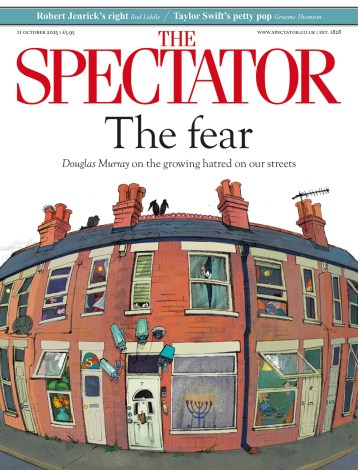Edward Lear liked to tell the story of how he was once sitting in a railway carriage with two women who were reading aloud to children from his Book of Nonsense. When a male passenger confidently asserted that ‘There is no such person as Edward Lear’, the writer was obliged to prove his own existence as ‘the painter & author’ (in that order) by showing the passengers his name on his hat, handkerchief and visiting card. In an extraordinary drawing of this event, Lear depicted himself and the two women realistically, but the doubting man is a cartoonish figure straight out of one of his limericks.
Lear’s two worlds of ‘art and nonsense’ wonderfully collide in this anecdote and its illustration. To be told that one does not exist nods at Lear’s feeling that his paintings were admired only by a select audience and places him in the absurdist position of the limericks’ protagonists. The sceptical gentleman is a representative of the poems’ ‘they’, that anonymous chorus of people who frequently question or challenge those whose eccentric behaviour makes them outsiders. As Angus Davidson eloquently put it in his 1938 biography of Lear:
‘They’ are the force of public opinion, the dreary voice of human mediocrity: ‘they’ are perpetually interfering with the liberty of the individual; ‘they’ gossip, ‘they’ condemn, ‘they’ are inquisitive and conventional and almost always uncharitable.
Lear’s life and work offer an invigorating rebuff to that banal majority.
He was born into a huge family in Holloway in 1812, programmed from birth to feel an outsider. His father was a sugar refiner turned financially unstable City broker, while his mother appears to have been more or less continuously pregnant. Of the 14 children who survived infancy, the sickly and myopic Edward was number 13. He never had any real bond with his mother, and was brought up instead by his eldest sister, Ann, who was 21 years his senior.
He suffered from asthma and developed a form of epilepsy at the age of five, which meant that apart from a brief, unsuccessful and unrecorded spell at school, he was educated at home in a predominantly female household, learning such traditionally ‘feminine’ accomplishments as drawing birds and flowers, writing verse and composing and performing songs.

These turned out to be far more useful to his subsequent career than anything he might have learned at a traditional public school, and in particular he proved to be an astonishingly gifted ornithological painter. Granted permission to draw birds from life at the newly opened Zoological Gardens in Regent’s Park, he published the first two parts of his spectacular Illustrations of the Family of Psittacidae, or Parrots when he was only 18.
The President of the Zoological Society, shortly to succeed his father as the 13th Earl of Derby, was sufficiently impressed by Lear’s exact but characterful paintings to invite him to make a record of the birds and animals he kept in his private menagerie at Knowsley Park in Lancashire. Occupying an ambiguous position between guest and employee, Lear would spend weeks on end at Knowsley painting Lord Derby’s birds and beasts.
It was also here, in a household ‘full of children bursting from the effort of being polite in grown-up company’, that Lear wrote his first limericks, their form based on comic verses in a book he’d found there, Richard Scrafton Sharpe’s Anecdotes and Adventures of Fifteen Gentleman (1822). Derby became a crucial early patron, and in 1837 would send Lear off to Rome to develop his skills as a landscape painter.
As Jenny Uglow beautifully observes, Lear’s watercolours of animals have ‘a feeling for the fast beat of a heart, the wetness of a twitching nose’, while his affinity with birds forms a constant thread in her book, in which each section has a wittily ornithological title, from ‘Fledging’ to ‘Swooping’.
Several of the subjects of Lear’s limericks either keep company with, or more or less become, birds, something emphasised in the poems’ gloriously scratchy illustrations: the Old Person of Nice adopting the forward-leaning motion of his geese; the Old Man of El Hums, who is barely distinguishable from the birds alongside whom he is pecking at crumbs; or the Old Man of White-haven whose beaky nose and lifted coat-tails make him the perfect partner for a raven in dancing a quadrille.
Lear asserted that ‘bosh requires a good deal of care’, and Uglow is very good indeed on the nonsense rhymes, really looking at the words and illustrations, both of which have sometimes been underestimated. She points out that the way the final line more or less repeats the first one is not a weakness, because the adjective often casts a different light on what has gone before, and that the form, conceived for an audience of children, ‘worked like a jack-in-the-box, springing a character into life, then snapping the box shut as it returned to the place of the opening line’.
She also emphasises the high level of violence in the poems, and it would be interesting to know if Lear had seen Heinrich Hoffmann’s Struwwelpeter, which was published in 1845, the year before the first Book of Nonsense. Lear’s Old Man with a poker bears a distinct resemblance to Hoffman’s long, red-legg’d scissor-man, while the Old Man of the Nile saws his own thumbs off, thus sharing the fate of Little Suck-a-Thumb.
Away from the nursery, Lear spent a great deal of his life travelling in pursuit of new subjects to paint and climates better suited to his precarious health. Looking back over 40 years at the sketches he had made, Lear listed some 30 journeys in search of topographical subjects, and Uglow is not the first of his biographers to struggle to convey this peripatetic aspect of his life without reducing it to an annotated itinerary.
Given what a good writer Lear was himself, the temptation to plunder his diaries and travel journals is irresistible, but the proliferation of places visited and people met sometimes overwhelms the narrative. Uglow does, however, give a real sense of just how intrepid a traveller Lear was and just how hard he worked, and she writes extremely well about both the paintings and the techniques he used to create them.
She is also excellent on Lear’s sometimes uneasy reliance on patronage, and his equally tricky relationship with Tennyson, lines of whose poems inspired many paintings. While remaining a keen admirer (and very funny parodist) of Tennyson’s work, Lear increasingly found the man unbearable, acutely referring to ‘the Anomaly of high souls & philosophical writings combined with slovenliness, selfishness & morbid folly’. He was devoted, however, to Tennyson’s much put-upon wife, Emily, who became perhaps his closest confidante. His deep friendship with her was without the tensions that arose in those with young men such as Franklin Lushington and Hubert Congreve.
Lear’s homosexuality, though probably never acted upon, has been acknowledged for many years, despite some rather desperate backpedalling by Peter Levi in his highly personal and idiosyncratic biography of 1995. Levi seemed bemused by Lear’s relationship with Lushington and insisted that Lear was ‘of course heterosexual’. Uglow takes Lear’s sexuality as read and devotes little space to the matter, simply stating that he was clearly in love with Lushington and that a ‘host of emotions, open and unacknowledged, clouded [his] feelings for’ Congreve.
She also notes that Lear’s vacillating and rather vague notion that he should marry — notably the many years he spent dithering over ‘dear little’ Gussie Bethell, a woman less than half his age — was devoid of romantic or sexual considerations. Lear’s supposed ugliness combined with his epilepsy (which he kept secret, learning to retire to the privacy of a room when he felt a fit coming on) made him feel unworthy, although he was still considering matrimony in his seventies — ‘a good woman to nurse me to the last’, as he unenticingly put it. What he most craved was companionship, and much of the melancholia that characterised his life arose from the sense that he was the only one among his many friends who had failed to find domestic contentment.
His later years were spent in San Remo, fondly but erratically tended by his long-serving Suliot manservant, Giorgio Kokali. Uglow rightly allots a good deal of space to Giorgio, but rather neglects that other important companion of Lear’s declining years, his delightfully stumpy-tailed and long-lived cat, Foss. Lear’s lifelong affinity with animals comes full circle in San Remo, and some of his most touching late works are the little caricature-portraits he drew of himself and this beguiling feline tottering into senescence together.
In an ideal world, one would also have liked more on the two gardens Lear created in San Remo, for they, like Foss, provided him with both solace and material for the vast number of charming and funny letters he continued to write to absent friends. ‘How pleasant to know Mr Lear,’ he mockingly wrote of himself, and readers of this detailed, affectionate and beautifully produced biography will surely agree.






Comments